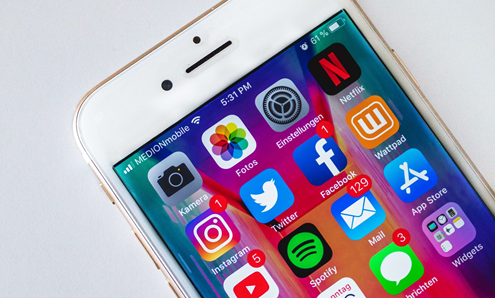Twitter is a social media platform like no other, offering opportunities for engagement and two-way dialogue for small business owners looking to build a loyal consumer base.
On average, Twitter boasts 460,000 new users every day (yes, day!) and if that’s pricked your ears up, wait until we hit you with some additional cold, hard stats:
- 13.7 million Brits can be reached by adverts on Twitter
- That’s a whopping 24% of the population you could potentially expose yourself to
- During March 2020 alone, Twitter users tweeted over 11.6 million posts and articles supporting local businesses.
Unsurprisingly then, Twitter is one of the most popular social platforms used by businesses to reach their customers and boost their success, but for you to get a slice of that pie it’s important you use it wisely, so buckle in for our 12 dos and don’ts of Tweeting.
1. #Don’t overstuff hashtags
Hashtags are a handy way to make your content reach a wider audience if used correctly, but overstuffing your Tweets with hashtags will have the opposite effect - it’ll turn users away.
Use your hashtags to categorise your tweets, link them to a trending news topic or debate, or direct users to your page if they’re in the market for your products or services, like this:
“Recent research suggests the average Brit spends 14 months of their life in the pub, do you think that sounds about right? We’d have thought it was more! #manchesterpubs #supportyourlocal”
If you pack your tweet full of hashtags, on the other hand, when users read it, it looks like a heap of links crammed into a short sentence, isn’t easy to digest, and can turn them off, like this:
“Recent #research suggests the average #Brit spends 14 months of their life in the #pub, do you think that sounds about right? We’d have thought it was more! #pub #publife #manchesterpubs #supportyourlocal”
Don’t overuse hashtags - do use them wisely and sparingly.
2. Do retweet wisely
In days gone by, retweeting someone else’s content was a matter of copying and pasting their post and adding ‘RT’ before posting it yourself - that’s now changed.
Twitter has now added a ‘retweet’ button below each tweet to make life easier, and clicking on it allows you to retweet their content simply, but this new method doesn’t allow you to add your own comments - and this isn’t necessarily a good thing.
Our top tip? Stick to the old method when you want to add your two pennies worth to someone else’s tweet - this could demonstrate your expertise, insights, and show you’re not just latching onto someone else’s.
The old method also puts your name on the tweet, rather than underneath it, which will spread brand awareness more effectively.
Do retweet relevant posts but add your own content - don’t just click ‘retweet’.
3. Don’t make your feed a sales pitch
Nothing will turn your followers off faster than constant self-promotions - Twitter users aren’t browsing the platform purely to be sold to, they want to see interesting and engaging content too.
Twitter is not a static advertising platform but an interactive site, so every tweet, or even every other tweet, shouldn’t be a sales pitch or some uninteresting information about your latest website update.
Instead, be useful and provide value to your users - share content you think they’ll be grabbed, amused, or informed by, and add a light sprinkling of self-promotion in-between.
Don’t constantly self-promote - do educate, inspire, engage, and occasionally pitch.
4. Do get personal
One of the biggest digital marketing trends of 2020 is personalisation - consumers want to feel like they’re engaging with a real person, not an automated ‘bot’, and they’ll react more favourably to tweets of a personal nature.
Again, this ties back in with the theme of self-promotion - here and there it’s fine, but intersperse that with some tweets about life in general - it could be a picture from your latest holiday #cocktailswithbreakfast, your kids playing at the park #dayoff, or some culture content (e.g. a video of your employees having fun at work) #officebants.
Do tweet about you, your interests, your life, etc. - don’t make it all about sales.
5. Don’t tweet all at once
We totally get that as a small business owner you’re always rushed off your feet, and so tending to your Twitter feed is likely a half an hour job before or after work.
The problem is if you only ever tweet at a certain time of day, and then tweet multiple times within that timeframe, it’s annoying to Twitter users. Why? Because they aren’t on the same schedule as you, they check their feed at different times, and if they wanted to engage with your business (which is ultimately your goal!), they can’t because they always miss your tweets.
If you find yourself in this predicament, the good news is there’s software out there that can help. The likes of Hootsuite and SproutSocial allow you to pre-plan your tweets and schedule them to be posted at particular times on certain days, allowing you to space your content out and reach a wider audience.
Don’t tweet all at once - do space out your tweets.
6. Do tweet with purpose
If you’ve been busy and neglected your Twitter feed for a while (let’s be honest, we’ve all been there), you might be tempted to just knock up a quick tweet to ensure your feed isn’t barren.
Don’t. If you don’t care about what you’re tweeting, no one else will. If you haven’t given your content any thought, no one else will give it a second thought either.
Tweeting for the sake of it is a big no-no and off the cuff tweets are more or less worthless to businesses. Concentrate on tweeting when you’ve got something interesting, entertaining, or insightful to say or share.
Do tweet with purpose - don’t tweet just for the sake of it.
Top tip: if you find yourself lacking inspiration for a killer tweet but you’ve not posted anything for a while, scour the web for some industry news you can tag onto.
7. Don’t follow everyone back
When you start out with your business Twitter account it can be tempting to try and up your follower and following numbers in an attempt to look established, but simply following everyone back who follows you is counterintuitive.
If your feed is full of useless, boring tweets this will be of little to no value to you and you might even end up missing out on content that would be useful to your business if reshared.
Instead, actively seek out accounts tweeting useful, meaningful content which would be a no-brainer for you to retweet and you’ll make your life a whole lot easier (plus help you out if you’re ever in a rut with your own content).
Don’t follow everyone back - do follow accounts that provide value.
8. Do widen your scope
Only using Twitter to follow businesses within your specific sector or industry might be your gut instinct, after all, they’re likely to tweet the most meaningful content for you, right?
Wrong. Your followers on Twitter are interested in your business and what you do, yes, but they’ll also have other interests outside of your industry just as you do too.
So while we’re not suggesting a hairdresser starts tweeting about office stationery, for example, you need to think outside the box and remember your follower-base has multiple passions.
Try and link in other industries wisely and you’ll be onto a winner. For example:
- A cheesemonger might share a tweet from a wine retailer and hint at how well the two would complement each other ‘cheese and wine night anyone?’, or
- A garden furnishing store might share a tweet from an ice cream shop and say ‘I can just imagine eating this with my feet up on our bestselling sunlounger #selfcare’.
Do follow businesses outside of your industry - don’t restrict your scope.
9. Don’t forget to reply to private messages
In the Twitter world, direct messages are akin to emails between tweeters and it’s not uncommon to find your inbox spammed with salesy messages, requests from influencers trying to establish a name for themselves, and so on.
This can make it tempting, in fact easy, to overlook your inbox and start to ignore it altogether, but don’t. Every so often there’ll be a message of value, perhaps someone asking for more details on your product, a query or even a complaint.
Naturally, ignoring this sort of message is not good for business, so it’s important you keep an eye out for genuine private messages.
Don’t overlook private messages - do check and respond to genuine messages.
Remember: you can only private message someone who is following your account, so this is another reason not to follow as many accounts as possible in an attempt to up your follower numbers.
10. Do respond to tweets @you and retweets
You’ll often find if you retweet someone else’s content on Twitter they’ll send you a quick ‘thank you’ message, and it’s important you don’t just ignore these.
Social etiquette applies on Twitter much the same as it does in the real world and you wouldn’t just blank someone who thanked you for doing them a favour, would you? So be sure to respond with something like ‘no problem, I thought it was really funny!’ (or similar).
The same applies the other way around if someone retweets your content, it’s common courtesy to acknowledge this with a quick ‘thanks for sharing!’ - it’ll paint you in a good light, up the chances they pay attention to your future tweets more, and could open up the door to potential future opportunities.
Twitter users might tweet @you for a whole host of reasons (queries, complaints, comments, etc.), and whatever the reasons it’s crucial you respond promptly - you can’t leave your followers hanging or it could do serious reputational damage.
Do respond to retweets and tweets @you - don’t leave your followers hanging.
11. Don’t forget about pinned tweets
Twitter gives you the option to pin a tweet to your feed, so don’t forget to make use of this feature if you’ve recently published a new blog post or released a new product.
By sticking it at the top of your feed you can be confident potential customers or consumers of your content won’t miss it, meaning you won’t miss out on website traffic or even sales because of timing.
Don’t forget about pinned tweets - do pin tweets when you’ve got something new to share.
12. Do include visuals
According to Twitter itself adding an image or GIF to your tweet is the easiest way to generate more attention to your post, and these stats are pretty conclusive:
- Tweets including images enjoy 150% more retweets than those without.
- Tweets with a GIF garner 55% more user engagement.
- Tweets including a video boast 10x more user engagement than regular tweets.
The takeaway?
Do incorporate imagery where it makes sense to do so - don’t stuff it in for the sake of it.
Head over to the takepayments blog for loads more useful guides like this one designed especially for small businesses.





